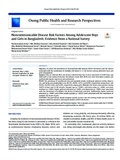| dc.contributor.author | Urmy, Nushrat Jahan | |
| dc.contributor.author | Hossain, Md. Mokbul | |
| dc.contributor.author | Shamim, Abu Ahmed | |
| dc.contributor.author | Khan, Md. Showkat Ali | |
| dc.contributor.author | Hanif, Abu Abdullah Mohammad | |
| dc.contributor.author | Hasan, Mehedi | |
| dc.contributor.author | Akter, Fahmida | |
| dc.contributor.author | Mitra, Dipak Kumar | |
| dc.contributor.author | Hossaine, Moyazzam | |
| dc.contributor.author | Ullah, Mohammad Aman | |
| dc.contributor.author | Sarker, Samir Kanti | |
| dc.contributor.author | Rahman, SM Mustafizur | |
| dc.contributor.author | Bulbul, Md. Mofijul Islam | |
| dc.contributor.author | Mridha, Malay Kanti | |
| dc.date.accessioned | 2022-05-25T04:32:26Z | |
| dc.date.available | 2022-05-25T04:32:26Z | |
| dc.date.copyright | 2020 | |
| dc.date.issued | 2020-12-11 | |
| dc.identifier.citation | Urmy, N. J., Hossain, M. M., Shamim, A. A., Khan, M., Hanif, A., Hasan, M., Akter, F., Mitra, D. K., Hossaine, M., Ullah, M. A., Sarker, S. K., Rahman, S. M., Bulbul, M., & Mridha, M. K. (2020). Noncommunicable Disease Risk Factors Among Adolescent Boys and Girls in Bangladesh: Evidence From a National Survey. Osong public health and research perspectives, 11(6), 351–364. https://doi.org/10.24171/j.phrp.2020.11.6.03 | en_US |
| dc.identifier.uri | http://hdl.handle.net/10361/16669 | |
| dc.description | This article was published in Osong Public Health and Research Perspectives [©2020 Korea Disease Control and Prevention Agency. This is an open access article under the CC BY-NCND license (http://creativecommons.org/licenses/by-nc-nd/4.0/).] and the definite version is available at: https://doi.org/10.24171/j.phrp.2020.11.6.03 The Journal's website is at: https://ophrp.org/journal/view.php?doi=10.24171/j.phrp.2020.11.6.03 | en_US |
| dc.description.abstract | Objectives: To assess the prevalence of noncommunicable disease (NCD) risk factors and the factors
associated with the coexistence of multiple risk factors (≥ 2 risk factors) among adolescent boys and
girls in Bangladesh.
Methods: Data on selected NCD risk factors collected from face to face interviews of 4,907 boys and
4,865 girls in the national Nutrition Surveillance round 2018-2019, was used. Descriptive analysis and
multivariable logistic regression were performed.
Results: The prevalence of insufficient fruit and vegetable intake, inadequate physical activity, tobacco
use, and being overweight/obese was 90.72%, 29.03%, 4.57%, and 6.04%, respectively among boys; and
94.32%, 50.33%, 0.43%, and 8.03%, respectively among girls. Multiple risk factors were present among
34.87% of boys and 51.74% of girls. Younger age (p < 0.001), non-slum urban (p < 0.001) and slum
residence (p < 0.001), higher paternal education (p = 0.001), and depression (p < 0.001) were associated
with the coexistence of multiple risk factors in both boys and girls. Additionally, higher maternal
education (p < 0.001) and richest wealth quintile (p = 0.023) were associated with the coexistence of
multiple risk factors in girls.
Conclusion: The government should integrate specific services into the existing health and non-health
programs which are aimed at reducing the burden of NCD risk factors. | en_US |
| dc.language.iso | en_US | en_US |
| dc.publisher | Osong public health and research perspectives | en_US |
| dc.relation.uri | https://ophrp.org/journal/view.php?doi=10.24171/j.phrp.2020.11.6.03 | |
| dc.subject | Adolescent | en_US |
| dc.subject | Boys | en_US |
| dc.subject | Girls | en_US |
| dc.subject | Bangladesh | en_US |
| dc.title | Noncommunicable disease risk factors among adolescent boys and girls in Bangladesh: Evidence from a National survey | en_US |
| dc.type | Journal Article | en_US |
| dc.description.version | Published | |
| dc.contributor.department | Brac James P. Grant School of Public Health | |
| dc.identifier.doi | https://doi.org/10.24171/j.phrp.2020.11.6.03 | |
| dc.relation.journal | Osong Public Health and Research Perspectives | |

